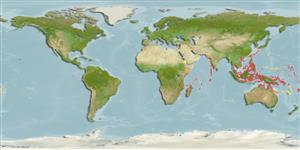Common names from other countries
分類 / Names
俗名 | 同種異名 | Catalog of Fishes(屬, 種) | ITIS | CoL | WoRMS | Cloffa
Teleostei >
Kurtiformes (Nurseryfishes, cardinalfishes.)
鱸形目 (Nurseryfishes, cardinalfishes.) >
Apogonidae (Cardinalfishes)
天竺鯛科 (Cardinalfishes) > Apogoninae
Etymology: Fibramia: Latin 'fibra' meaning thread or filament and the feminine Greek 'amia' often applied as an ending for some cardinalfish genera as well as an incorrect past usage as a cardinalfish genus. The name refers to two characteristics of the species in this genus, an elongate second dorsal spine in one species and the narrow, pale or dark mid-line on the body of two species..
More on author: Bleeker.
Environment: milieu / climate zone / depth range / distribution range
生態學
海洋; 淡水; 半鹹淡水 礁區魚類; 深度上下限 2 - 5 m (Ref. 11890). 熱帶; 32°N - 23°S
Indo-West Pacific: Zanzibar (Tanzania) eastward to Southeast Asia, and north to Amami-ôshima (Japan) southward to Taiwan, Palau, Philippines and New Guinea east to the Solomon Island and New Caledonia.
印度-西太平洋: 桑吉巴 (坦尚尼亞) 向東至東南亞, 而且北至 Amami-oshima(日本) 向南至台灣,帛琉, 菲律賓,而且新幾內亞東至所羅門島與新加勒多尼亞。
大小 / 重量 / 年齡
Maturity: Lm ? range ? - ? cm
Max length : 7.0 cm SL 雄魚/尚未辨別雌雄; (Ref. 7050)
背棘 (總數) : 7; 背的軟條 (總數) : 9; 臀棘: 2; 臀鰭軟條: 8. Distinguished by having the following characteristics: dorsal-fin rays VI-I, 9; anal-fin rays II, 8; pectoral-fin rays 14; pelvic-fin rays I, 5; pored lateral-line scales 24; predorsal scales 7; circumpeduncular scales 12; total gill rakers 21-22, developed gill rakers 19-20; light brown body; two black stripes, one from snout to opercular margin through eye, and the second one on anterior portion of lateral line; blackish anterior part of first dorsal fin; base of caudal-fin with distinct black spot (Ref. 93839).
達到 7 公分TL 。
Found in brackish water at river mouths and among the mangroves. Also enters freshwater during low tide. Mouth brooding by males (Ref. 559).
在河口發現於半淡鹹水了與在紅樹林之中。 也在低潮的時候進入淡水。 孵雄性的嘴.(參考文獻 559)
Life cycle and mating behavior
Maturities | 繁殖 | Spawnings | Egg(s) | Fecundities | 仔魚
Mouthbrooders (Ref. 240). Distinct pairing during courtship and spawning (Ref. 205).印度-西太平洋: 桑吉巴 (坦尚尼亞) 向東至東南亞, 而且北至 Amami-oshima(日本) 向南至台灣,帛琉, 菲律賓,而且新幾內亞東至所羅門島與新加勒多尼亞。
Masuda, H., K. Amaoka, C. Araga, T. Uyeno and T. Yoshino, 1984. The fishes of the Japanese Archipelago. Vol. 1. Tokai University Press, Tokyo, Japan. 437 p. (text). (Ref. 559)
CITES (Ref. 128078)
Not Evaluated
人類使用
工具
特別的報告
下載 XML
網路資源
Estimates based on models
Preferred temperature (Ref.
115969): 25.4 - 29.3, mean 28.7 (based on 1895 cells).
Phylogenetic diversity index (Ref.
82804): PD
50 = 0.6250 [Uniqueness, from 0.5 = low to 2.0 = high].
Bayesian length-weight: a=0.01479 (0.00690 - 0.03171), b=3.09 (2.91 - 3.27), in cm Total Length, based on LWR estimates for this (Sub)family-body shape (Ref.
93245).
營養階層 (Ref.
69278): 3.7 ±0.5 se; based on size and trophs of closest relatives
回復力 (Ref.
120179): 高度, 族群倍增時間少於 15個月 (Preliminary K or Fecundity.).
Fishing Vulnerability (Ref.
59153): Low vulnerability (10 of 100).
